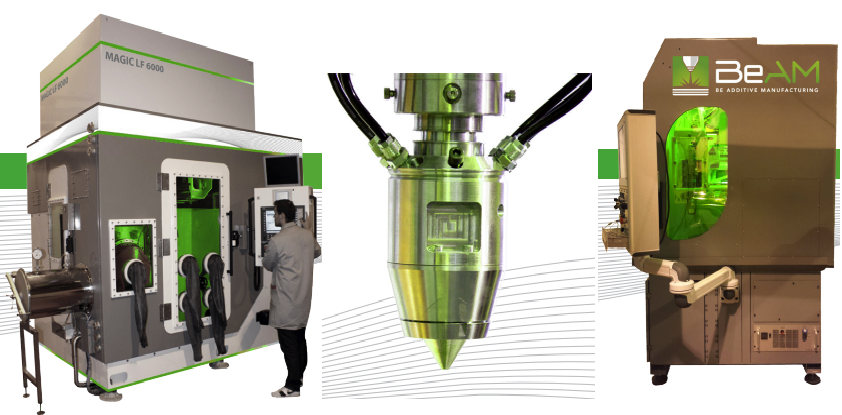 The 3D printing of metal promises to change the face of manufacturing worldwide over the next decade. While the technology is still only very young, the rapid acceleration and innovation within the space will allow companies to streamline the manufacturing of multiple components, greatly increasing design variability, and reducing the space required on the manufacturing floor, as a single machine may be able to replace dozens. Before we get to this point, however, the technology must become more affordable, faster, and perhaps a bit more precise. Further innovations are required within the space and one company based out of Illkirch, France seems to be doing just that.
The 3D printing of metal promises to change the face of manufacturing worldwide over the next decade. While the technology is still only very young, the rapid acceleration and innovation within the space will allow companies to streamline the manufacturing of multiple components, greatly increasing design variability, and reducing the space required on the manufacturing floor, as a single machine may be able to replace dozens. Before we get to this point, however, the technology must become more affordable, faster, and perhaps a bit more precise. Further innovations are required within the space and one company based out of Illkirch, France seems to be doing just that.
BeAM, founded in 2012, is already making strides within the additive manufacturing space, particularly in Europe. They’ve been able to develop a new technique of metal 3D printing which they call CLAD, and not only do they manufacture metal components with this process, but they also are able to repair damaged parts, working with several companies, particularly within the aerospace industry.
You all are likely familiar with the metal 3D printing processes of Direct Metal Laser Sintering (DMLS) and Selective Laser Sintering (SLS), where a bed of metal powder is selectively melted via a high-powered laser beam. BeAM’s CLAD technology works also by melting metal powder, but differs greatly in the fact that no powder bed or sifting of powder is required.
Closely partnered with IREPA LASER, BeAM is able to leverage the advancements inherent within IREPA LASER’s laser technology to create a streamlined additive manufacturing process. BeAM’s 3D printers rely on their important patented CLAD nozzle system which is able to extrude two streams of metal powder at the same instant that a high-powered laser is active. The laser instantaneously melts the extruded metal powder as the nozzle moves along the X and Y axes based on computer input data. An object can then be printed or repaired one layer at a time as you can see from the video below.
Mobile CLAD
- Machine Size: 1200 x 1500 x 2000 mm
- Build Envelope : 400 x 250 x 250 mm
- Configuration of the axes: 3 axes (XYZ)
- Layer Thickness: 0.1 to 0.3 mm/layer
- Powder Size: 45 – 75 µm
CLAD Unit
- Build Envelope: 1000 x 700 x 700 mm
- Configuration of the axes : 3 axes (XYZ) with up to 5 continuous axes (BC)
- Layer Thickness: 0.2 to 0.8 mm/layer
- Power Size: 45 – 90 µm
- Options: One or two nozzles; one or two powder bowls making multiple material deposition possible
MAGIC
- Machine Size: 4.37 x 3.94 x 3.5 m
- Build Envelope: 1500 x 800 x 800 mm
- Configuration of the axes : 3 axes (XYZ) with up to 5 continuous axes (BC)
- Layer Thickness: 0.2 to 0.8 mm/layer
- Powder Size: 45 – 90 µm, 50 – 150 µm
- Options: One or two nozzles; one or two powder bowls making multiple material deposition possible
BeAM is already working with numerous companies, and they have repaired hundreds of parts including aircraft engine turbines. In fact, they’ve partnered with the US-based company Chromalloy to repair numerous types of Pratt & Whitney parts, increasing the operating life of some components from 10,000 to 60,000 hours according to the company. BeAM has also assured us that they are continuing to innovate as they work with a variety of partners to further improve their CLAD technology. For all pricing details, the company asks potential clients to contact them via their website.
BeAM’s approach is certainly an interesting one, both in their method of printing, and their ability to print on already constructed parts for repairs. Let’s hear your thoughts on BeAM’s advanced 3D printing technology, and how 3D printing could find a niche within the metal repairs industry as well. Discuss in the BeAM 3D Printers forum thread on 3DPB.com.
Subscribe to Our Email Newsletter
Stay up-to-date on all the latest news from the 3D printing industry and receive information and offers from third party vendors.
You May Also Like
3D Printing Unpeeled: Biofuel Waste to Filament & Sustainable Photopolymers
I can’t ever remember a day with so many potentially high impact news stories have come out. In one story, we all know that there are problems with the safety...
Finnair Hires AM Craft to 3D Print Plastic Parts for Aircraft Interiors
Riga-based AM Craft, a supplier specialized in 3D printing aviation components and certified under EASA Part 21G, announced a significant achievement today. The company will assist in upgrading Finnair’s A320...
3DPOD Episode 198: High Speed Sintering with Neil Hopkinson, VP of AM at Stratasys
Neil Hopkinson, a pioneering 3D printing researcher, played a pivotal role in developing a body of research that is widely utilized today. He also invented High Speed Sintering (HSS), also...
3D Printing Webinar and Event Roundup: May 12, 2024
Webinars and events are picking up in the AM industry this week! ASTM International continues its Professional Certificate Course and Stratasys continues its advanced in-person trainings, while 3D Systems is...


































